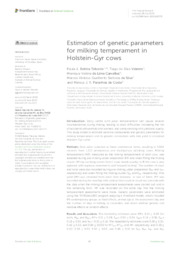Estimation of genetic parameters for milking temperament in Holstein-Gyr cows.
Estimation of genetic parameters for milking temperament in Holstein-Gyr cows.
Autoria: TABORDA, P. A. B.; VALENTE, T. da S.; CARVALHAL, M. V. de L.; SILVA, M. V. G. B.; COSTA, M. J. R. P. da
Resumo: Introduction: Dairy cattle with poor temperament can cause several inconveniences during milking, leading to labor difficulties, increasing the risk of accidents with animals and workers, and compromising milk yield and quality. This study aimed to estimate variance components and genetic parameters for milking temperament and its genetic correlations with milk yield in crossbred Holstein-Gyr cattle. Methods: Data were collected at three commercial farms, resulting in 5,904 records from 1,212 primiparous and multiparous lactating cows. Milking temperament (MT), measured as the milking temperament of each cow, was assessed during pre-milking udder preparation (RP) and when fitting the milking cluster (RF) by ascribing scores from 1 (cow stands quietly) to 8 (the cow is very agitated, with vigorous movements and frequent kicking). The number of steps and kicks were also recorded during pre-milking udder preparation (SRP and KRP, respectively) and when fitting the milking cluster (SRF and KRF, respectively). Milk yield (MY) was obtained from each farm database. In two of them, MY was recorded during the monthly milk control (that could or could not coincide with the date when the milking temperament assessments were carried out) and in the remaining farm, MY was recorded on the same day that the milking temperament assessments were made. Genetic parameters were estimated using the THRGibbs1f90 program applying a threshold model, which included 89 contemporary groups as fixed effects, animal age at the assessment day and the number of days in milking as covariates, and direct additive genetic and residual effects as random effects. Results and discussions: The heritability estimates were MT= 0.14 ± 0.03 (for both, MRP and MRF), MY= 0.11 ± 0.08, SRP= 0.05 ± 0.03, KRP= 0.14 ± 0.05, SRF= 0.10 ± 0.05, and KRF= 0.32 ± 0.16. The repeatability estimates were 0.38 ± 0.05, 0.42 ± 0.02, and 0.84 ± 0.006 for MTRP, MTRF, and MY, respectively; and 0.38 ± 0.02, 0.30 ± 0.07, 0.52 ± 0.02, and 0.46 ± 0.15 for SRP, KRP, SRF, and KRF, respectively. The estimates of most genetic correlation coefficients between MTRP-MTRF were all strong and positive (MTRR-MTRF= 0.63 ± 0.10, MTRP-SRP= 0.65 ± 0.12, MTRP-KRP= 0.56 ± 0.16, MTRF-SRF= 0.77 ± 0.06, and MTRF-KRF= 0.56 ± 0.34) except for MY (MTRP-MY= 0.26 ± 0.26 and MTRF-MY= 0.21 ± 0.23). Despite the low magnitude of MT heritability, it can be included as a selection trait in the breeding program of Holsteins-Gyr cattle, although its genetic progress will be seen only in the long term. Due to the low accuracy of the genetic correlation estimates between MT and MY and the high range of the 95% posterior density interval, it cannot be affirmed by this study that the selection of a milking temperament trait will infer on milk yield. More data is therefore needed per cow and more cows need to be observed and measured to increase the reliability of the estimation of these correlations to be able to accurately interpret the results.
Ano de publicação: 2023
Tipo de publicação: Artigo de periódico
Unidade: Embrapa Gado de Leite
Palavras-chave: Correlação genética, Gado Holandês, Gado Leiteiro, Girolando, Herdabilidade, Parâmetro Genético, Reatividade, Trabalhabilidade
Observações
1 - Por padrão são exibidas publicações dos últimos 20 anos. Para encontrar publicações mais antigas, configure o filtro ano de publicação, colocando o ano a partir do qual você deseja encontrar publicações. O filtro está na coluna da esquerda na busca acima.
2 - Para ler algumas publicações da Embrapa (apenas as que estão em formato ePub), é necessário ter, no celular ou computador, um desses softwares gratuitos. Sistemas Android: Google Play Livros; IOS: iBooks; Windows e Linux: software Calibre.
Acesse outras publicações
Acesse a Base de Dados da Pesquisa Agropecuária (BDPA) para consultar o acervo completo das bibliotecas da Embrapa.

